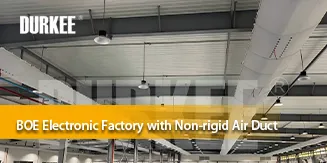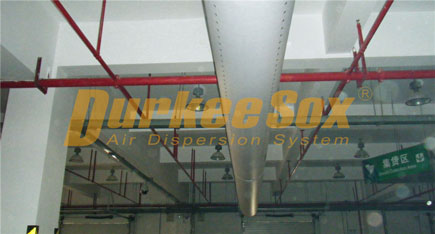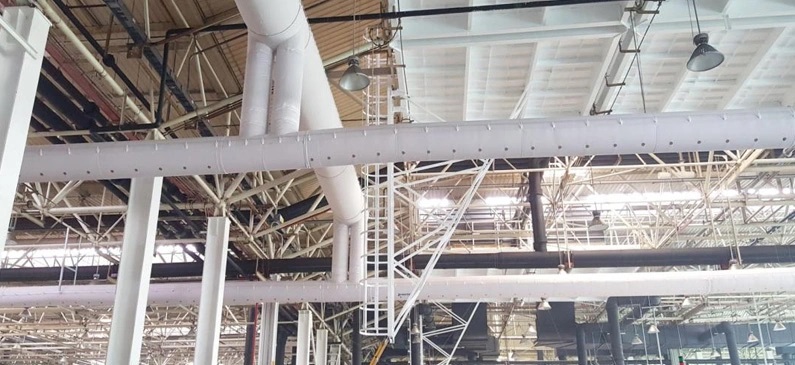 BOE Vietnam Factory: Non-rigid Air Duct Solutions for Electronic Industry
BOE Vietnam Factory: Non-rigid Air Duct Solutions for Electronic Industry
 Why Fabric Air Ducts Are the Preferred Choice for Ventilation in Large Spaces
Why Fabric Air Ducts Are the Preferred Choice for Ventilation in Large Spaces
 The Difference Between Non-Rigid Air Ducts and Rigid Ductwork
The Difference Between Non-Rigid Air Ducts and Rigid Ductwork
As the Paris Olympics unfold, the city is bustling with activity, welcoming over 10,500 athletes from 206 NOCs, alongside an impressive crowd of more than 600,000 spectators. This historic event, featuring over 300 events across 45 sports, is a testament to the Olympic spirit and the dedication of all involved.
However, with the summer heat in Paris, and the average temperatures soaring above 25°C (77°F), the comfort and performance of both athletes and spectators are paramount. The necessity of efficient air conditioning and ventilation systems cannot be overstated.
Fabric air ducts, also known as textile ductwork or HVAC duct sock, are a versatile alternative to traditional metal duct systems. Fabric air conditioning ducts are flexible air exchange terminals composed of special fibers, that allow for superior air dispersion and distribution. Unlike traditional gi ducts that can suffer from inefficiencies due to leaks or uneven air flow, fabric duct systems provide a more consistent and controlled air dispersion throughout the space.
Fabric ducting ensures an even distribution of airflow across the entire playing surface. This consistency is vital for athletes, as it provides an equal environment for all competitors, reducing the impact of external factors on their performance. The use of fabric air conditioning ducts allows for precise control over airflow velocity, contributing to a more level playing field.
The comfort of spectators is paramount for the success of any sports event. Fabric ducting systems maintain optimal indoor air quality and temperature, ensuring that fans can enjoy the game in a comfortable setting. This is particularly important for large venues where traditional air conditioning systems may struggle to provide even temperature distribution.
Sports venues with aquatic facilities face unique challenges because of the corrosive nature of chemicals used in pools. Fabric ducting, with its corrosion-resistant properties, effectively manages air dispersion, improving indoor air quality by controlling humidity and chemical levels. This not only benefits the health of the athletes but also extends the lifespan of the facility.
For ice arenas, fabric ducting provides a comprehensive solution to the challenges posed by high humidity and the need for even air distribution with low air velocity. It creates a comfortable thermal environment in the auditorium and prevents direct contact between the air and the ice surface, thereby maintaining optimal playing conditions.
The hygiene of a sports venue is crucial for the health of both athletes and spectators. Fabric air ducts are easily cleaned and laundered, ensuring a high standard of cleanliness. Also, they are strong and can handle the damage from sports equipment, keeping their shape and performance for a long time.
One of the key advantages of fabric ducting is its energy efficiency. These flexible air ducts often require less energy to operate compared to traditional metal ducts. This is due to the ability to facilitate better airflow, reducing the load on heating and cooling systems. As a result, fabric air ducts contribute to lower energy consumption and operational costs.
When incorporating fabric air ducts into sports venue air systems, it’s important to ensure compatibility with existing HVAC systems. Fabric ducting can be integrated into both new and existing heating, ventilation, and air conditioning (HVAC) systems. Their ease of installation and maintenance makes them a practical choice for upgrading air conditioning systems in sports arenas.
Fabric air ducts offer a range of benefits for sports venues, including improved air distribution, energy efficiency, and enhanced indoor air quality. By leveraging the advantages of fabric ducting, sports venues can create a more comfortable and healthier environment for both athletes and spectators. As the demand for advanced air distribution solutions grows, fabric air ducts are poised to play a significant role in the future of sports venue air systems.
CASE STUDY:
How fabric air conditioning ducts solve the air dispersion and condensation challenges in ice arenas